You are in THE STRATEGY ZONE.
This is our introduction to strategy, understanding strategy, exploring the language of strategy, strategic thinking, developing strategy and making strategy happen. Inspired through 25 years of helping clients with their strategies. It is a structured route into the practical advice, opinion pieces, case studies we have written over the years about aspects of strategy.
Browse the contents list, drop down to the longer sections, follow the links to articles, or to talk about your strategy challenges, simply give us a call.
Contents: aspects of strategy to explore and learn
Our STRATEGY ZONE covers ten major themes of strategy. Follow the links in this contents list to find articles and topics which will lead you to the various strategy articles on the site. The ten strategy themes are:
- The language of strategy & what is not a strategy
- Understanding strategy and what is a Good strategy
- Why do strategies fail?
- Strategy as learning: Continuous emergent strategy
- How the Fourth Generation Strategic Balanced Scorecard approach helps with strategy
- Developing and facilitating strategy: the importance of quality of thinking, conversation and decision making
- Strategy, future thinking, uncertainty and risk
- Testing a strategy: Testing a strategy document.
- Your strategy’s impact: Inside and outside the organisation
- Making strategy happen: Culture, alignment, cascading, communicating and measuring.

What clients have said about our strategy work:
“This project has been remarkable. There has been so little resistance and so much take up so quickly. We have not encountered that before.”
Steve Inch, Director, Dimensions: Client for Strategic Balanced Scorecard at Board and Regional level
“I can’t think of another example of a project where there has been such sign-up to the approach from every directorate.
Peterborough City Council: Strategy and Strategic Balanced Scorecard project
We have not embedded things in the same way before.
1 The language of strategy: Definitions, explanations and what is not a strategy
When we are facilitating strategy for clients, we are very conscious of the language we use and the language about strategy of the team we are working with. It is vital we mean the same thing when we talk about the various aspects of strategy. That way, we all understand what each other is saying at any point in the strategy discussion.
1.1 Definitions of strategy
One of the frustrations I have is that the word strategy is misunderstood and used badly. Over the years I have I have come across around twenty different ways in which the words strategy and strategic are used. Some are very dangerous and some confusing. Some are useful, and some insightful. These articles will help you unpick the basic language of strategy and it common uses:
- The origins of the word strategy and variations on the word.
- The language of strategy: A military perspective.
- For fun, have a read of Strategy is not the same as Important.
- Oh and please do not confuse mission, purpose and vision
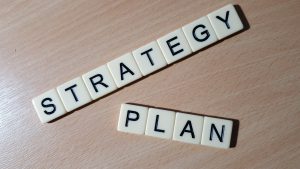
A common and dangerous confusion is between strategy and planning. We find people write ‘strategic plans’, when they should be writing a strategy document. To understand the differences read:
- What is the difference between strategy and planning
- A strategy document is different to a strategic plan.
The further articles under bad strategy and good expand on other definitions of strategy
1.2 Understanding strategy and what is Good Strategy
Before we explore what makes a strategy, we need to expose what is NOT a strategy.
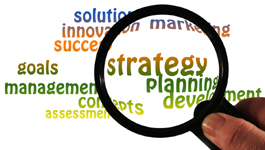
- What is a strategic objective? Well it is not a strategy!
- Some strategy statements are oversimplified. They do not provide a strategy. When you look at a strategy document, beware of oversimplified strategy statements.
- Make sure you understand that Strategy is not the same as important.
- Don’t let anyone tell you otherwise: Passion is NOT a strategy!
- Sometimes people think strategy is “We thought about it”
- It’s a strategy, but is it useful? The dangers of copycat strategy
2 What is a strategy & what is good strategy
When we are working with clients we need to know when to push them further and when we really have their strategy. We have different ways to test strategies and ensure they are robust, complete and meaningful. One of the key criteria is knowing what constitutes a strategy and what not. We have adopted a number of core models of strategy that we apply.
2.1 How do we know when we have a strategy?
Here are three ways of looking at a strategy, that you might not normally think of:
- Good Strategy turned into a Strategy tablet: Based on the work of Richard Rumelt, refined through multiple strategy engagements. Our clients find this Strategy tablet approach creates a depth of thinking and quality of conversation around their strategy. Using the Good strategy bad strategy approach, to develop strategy
- Strategy as a persistent pattern of behaviour: This is both powerful and useful. It teases out the different between strategy as written or spoken about, and the one actually being followed. Find out more about Strategy as a persistent pattern of behaviour (This approach is helpful in recognising when your strategy has become so persistent a behaviour, it has become a habit, or even an addiction).
- Strategy as a framework for decisions: Are the words in your strategy useful? Good strategy should contain coherent decisions and actions. Arguably a strategy is not complete without the set of coherent decisions. So, a good test of a good strategy is, “Does our strategy frame and guide subsequent decisions?”
Some alternative ways to frame how you think about your Strategy
- Strategy as a hypothesis: If you are working on strategy you need to think of Strategy as a hypothesis. Thinking of your strategy as a hypothesis may change how you think about how your process of implementation and you process of managing your strategy. Read Strategy as a hypothesis.
- A good strategy needs an argument: In fact, find out why we believe a Good strategy needs two arguments
2.2 Two book recommendations
Our approach to strategy is influenced by clear writers about strategy, as well as experience of working on strategy engagements for over 20 years. For clients who want to read more about strategy, I recommend two books that are must reads: Richard Rumelt’s Good Strategy Bad Strategy, and Henry Mintzberg’s Strategy Safari. Both books will help you think more widely about strategy.
2.3 Strategy should include how we manage
One aspect of strategy that gets forgotten is rethinking and assessing how we lead and how we manage. This is not simply about managing the strategy. It is about the wider aspects of how we choose to manage. How we choose our systems and approach to management. To widen your thinking, have a read of:
- “Is how we manage” missing from our strategic thinking?
- An example of a Chief executive thinking about how she chooses to manage.
- Our Fourth generation Strategic Balanced Scorecard Approach is about more flexible management systems.
3 Why do strategies fail? Rumours, myths and realities

There are lots of reports and statistics that most strategies fail to implement what they set out to achieve. Having been involved in the design and analysis of such a survey, I do not believe things are anything like as bad as the headlines and scaremongers would like us to believe. There are of course implementation challenges, which we explore in these articles:
- First, let us bust the big myth about strategy failing: Do 9 out of 10 strategies fail? I don’t think so
- There is a view (Forbes magazine) that the challenge is not bad strategy: It is bad execution. We explore why this is said and what it really means in The strategy execution challenge.
- Implementing strategy can be a challenge when the nature of the organisation is to want things to be perfect. As one Chief Executive I worked with put it, “Polishing strategy, not implementing strategy: The problem is our people have big brains”
Client quotes about our strategy work:
“The reason we like working with you is that you are sympathetic to our style of thinking and working and adapt to it.”
Dr Astrid Bonfield, Chief Executive Diana Princess of Wales Memorial Fund. Client for Strategic Balanced Scorecard and future thinking
4 Understanding Strategy as learning and emergent strategy
Perhaps one of the biggest shifts we are seeing is that organisations are now seeing strategy as a more emergent, learning process.
Traditionally (or since the 1960’s) organisational strategy is seen as very deliberate and annual. Instead they recognise that strategy can be emergent, and parts of their strategy might be both deliberate, while other parts are more emergent. Emergent strategy requires a different way of thinking about how you manage the strategy process. It is more contingent. It is deliberately a process of learning about and from the strategy. Here are some articles on emergent strategy and strategy as a learning process.
Is, being able to learn faster than our competitors, our only sustainable source of competitive advantage? It is about organisational Learning as a strategy. If you are going to understand how to learn from your strategy, make sure it is Rigorous, intellectually honest learning about your strategy. And just in case you were wondering, Emergent strategy is not lazy strategy
One aspects of understanding strategy in learning organisations is the challenge of persistency vs the need for refinement and change. Here are three articles on the challenges this creates:
- Strategy as a persistent pattern of behaviour
- The case for humble strategy
- Three thoughts on strategy in learning organisations: Persistent, habits and humble
Overall it is clear that Strategy has become a continuous learning process. Central to our approach is the Strategic learning model. Adopting this models enables you to to learn to Manage strategy as a learning process.
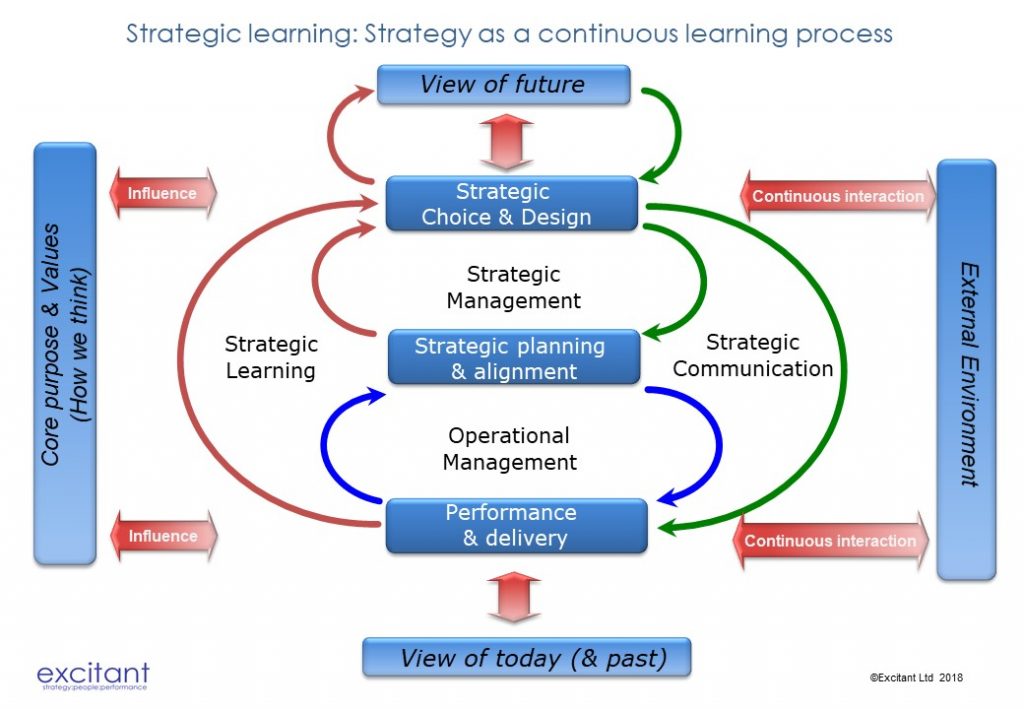
People often link learning and agility. They are, or course related, but as the strategic learning model shows, you can’t jump straight to organisational agility: Organisational agility requires two preceding capabilities.
If you want to move to emergent strategy: Make sure your traditional performance management approach does not stop you A better approach is to apply 4G Strategic Balanced Scorecard principles: because that is how we think about strategy as a continuous learning process
As strategy consultants we have been helping our clients implement strategic learning and emergent strategy for over 20 years. Our 4G Strategic balanced scorecard approach is designed as a strategic learning process. Learn more by contacting us
Back to contents list
5 How our Fourth Generation Strategic Balanced Scorecard approach helps strategy
We developed the Fourth Generation Strategic Balanced Scorecard approach to address the many issues we encountered when working with thoughtful clients who wanted to create real change in strategy and performance. Here are some articles where you can learn more about the Fourth Generation Strategic Balanced Scorecard approach:
- A good place to start is our Strategy Mapping 101 video. It dispels a load of myths and mis-understandings about how a strategic balanced scorecard approach works. Strategy mapping 101 video.
- Treating strategy as a learning process is at the heart of the 4th Generation Strategic Balanced Scorecard approach. To understand how the Strategic Learning model helps create the right conversations at the right time, learn about The Strategic Learning Model.
- The 4G Strategic Balanced Scorecard principles: How we think about strategy
- To help the quality of conversation, the strategic balanced scorecard is a social tool, not a technical tool.
When we are working on strategy we build it up in layers and themes. This ensures a thorough understaidning the strategy and how the startegy map is created.
- We start with a core model of change,
- Then we refine that for the specific operating of business model for the organisation and its environment/context (Strategy maps need a clear and explicit business model)
- Then we understand and overlay the pressures, challenges and strateic tensions in the organisation.
- Only then do we start to overlay this model with with the strategy and strategic themes
- Finally, we develop the strategic objectives within each perspective and ensure there is a genuine cause and effect model between the objectives in each perspective.
- The importance of strategic themes, for structure and especially for strategy communication
This structured approach to developing the startegy map model to hold the strategy, ensures that we understand each aspect of the organisation, and the Executive team are happy with that model represents their strategy. Making the layers explicit, helps the team to articulate the variations, subtlties and nuances of their strategy as the strategy map is developed. (I have known this process run through over fifteen iterations until the final one is reached, and all of the Executive team are happy with it and own it).
6 Developing & facilitating Strategy
When we facilitate strategy for a client we are focused on the quality of thinking, the quality of conversation and the quality of decision making. We tell clients we want them to have a good argument (It is better to have it now, rather than leaving the room and having the arguments later). This section explores aspects good strategy facilitation.
6.1 Quality of conversation and robust strategic thinking
Phil Jones, our Chief Executive has been facilitating strategy for over twenty years, in organisations as diverse as FTSE100 retailers, International Banks, Charities, Local Councils, Start-ups and networked organisations. To find out more simply contact our Chief Executive, Phil Jones.
- Our overall approach to strategy workshops and facilitating robust strategic thinking
- This is a case study of a “strategic planning” session involving management teams from four different countries coming together for the first time. It contains some useful advice. Useful lessons from a strategic planning workshop.
- Strategy, analysis and decision making as a conversation
- When facilitating strategy, you need a good argument. It is about the quality of conversation.
If you are serious about having a robust conversation about your strategy, then get in touch.
6.2 Quality of strategy relies on quality of decision making and taking
Our work facilitating many strategies has made it really clear that the Executive team’s quality of decision making and decision taking is fundamental to good implementation.
When facilitating strategy, we help clients make and take good decisions, as a team, so they leave the room all telling the same story. Clients love our six-step decision process. It helps them track where they are in a conversation and a decision. We strongly recommend you have a look at articles from our Decision Improvement Zone. Here are a few key ones:
- Excitant’s six-step decision process
- What is the difference between making and taking a decision?
- And why do we not notice the difference between decision making and taking?
- And just for fun: Six frogs on wall, two decide to jump off. How many are left?

We are great admirers of the work of Nobel prize winning economist Daniel Kahneman. His approach throws light of strategic thinking and decision making, particularly how we might recognise cognitive errors. His work has influenced our strategy facilitation approach consultancy work. It is worth having read of:
- Thinking fast and slow: Lessons for the annual off-site
- Thinking fast and slow about strategy and decision making
- Thinking fast and slow: How we really make Executive decisions
- Why use a KPI: beware the KPI substitution heuristic
You can read more about how to improve decision making in the organisation, and the wider implications of decision making and taking for strategy in our Decision improvement zone.
Back to contents list
7 Strategy, Future thinking, uncertainty and risk
7.1 Strategy and future thinking

When we work on strategy with clients, we start by helping them build a tangible future: A view of how specifically their environment might change over the next few years (their planning horizon). They also develop a separate tangible future for the organisation that describes their expected pace of internal change (which should of course relate to the external one).
Both of these tangible future views are tested against the strategy.
Video Case study: Tangible future, strategy map and technology road map for manufacturing company. Though that case study is for a manufacturing company, the principles in this video are just as applicable to most organisations. Tangible futures serve three purposes. Read about these different purposes and strategy maps and the tangible futures work together in “Strategy maps and tangible futures”. The tangible future approach puts meat on vision and mission statements especially when used alongside a strategy map. (You can find out how we do these in my book “Strategy Mapping for Learning organisations” chapters 4 and 5).
7.2 What planning horizon should I use for my strategy?
The tangible future approach puts meat on vision and mission statements especially when used alongside a strategy map. Our clients have wanted to explore strategy and impact over timescales ranging from just one year (A critical crisis) through to 60 years (influencing a whole sector). It is more common to work on around 3-5 years. If you are thinking about your planning and strategy horizon, have a read of “What planning horizon should I use for my strategy?”
One client was complaining their managers could not think long term. As consultants, we have to get past the presenting problem to the underlying problems and causes. When we looked behind this, we found that, ‘not doing long term thinking’ was a learnt behaviour. They had been implicitly trained by the Executive team to think more short term. This article explores how that had happened and what we did to help that client unpick the underlying causes and start to change to more long-term thinking. Have a read of What stops long term thinking and planning in an organisation? It might give you some thoughts about your organisation.
7.3 Testing your strategy against the future: Scenario modelling
A key question for us is “Is this strategy both realistic and is it robust? It is important to be skeptical about a strategy. You would not fly an aeroplane that had not been tested to its limits of flight in a wind tunnel or by a test pilot. Why would you fly an untested strategy?
To answer these sorts of questions, we usually use some form of scenario modelling alongside the analysis of the uncertainties and risks exposed in the tangible futures.
We use various methods of scenario analysis, from classic scenario planning (the 2×2 matrix of contrasting cases) to simply creating alternative finance or market conditions from which the client can examine the implications for their finances, operations and proposed strategy. What we use, and how we use them, depends on the client’s situation, the planning horizons involved and the uncertainties and challenges that are emerging.
Some of our clients have used multiple scenario modelling to provide alternative pictures of how the future might evolve. They have then looked at their strategy and asked the question, “Is this strategy robust enough to work in that scenario?”
Other Management teams may spontaneously recognise that the picture of the future they had created need to be reconciled against their strategy to ensure that the strategy addressed all the aspects of their future view. In effect, they tested their strategy against their anticipated future and its uncertainties and risks. Learn how they did this in “Why fly an untested strategy? Testing your organisation’s strategy against the external environment”
7.4 Strategy, uncertainty, risk and the 4G Strategic Balanced Scorecard

How the Fourth Generation Strategic Balanced Scorecard approach helps you manage uncertainty and risk
- Using the tangible future to identify and manage external uncertainty and develop external predictive indicators (EPIs)
- One way to manage external risk is to use External predictive indicators: A new class of indicators on a 4G strategic balanced scorecard
- A 4G Strategic Balanced scorecard can help in uncertain environments
- There are some clear ways that a modern, 4G Strategic Balanced Scorecard approach can help you manage uncertainty
- Some people argue that Balanced scorecards do not manage risk. Our Fourth Generation Strategic Balanced Scorecard approach does manage some risks, but it depends on the class of risk; Balanced scorecards and risk management: It depends on the class of risk
8 Testing a strategy
8.1 Testing a strategy: when reading a strategy document
When reading strategy documents, as a strategy consultant, it is useful to have some tests that we can apply to check the coherence of the strategy and the statements in the document. Here are some ways we test a strategy document, that are easy for you to apply as well:

- We have a simple way of testing the depth of thinking in any strategy document: We call it the four-pen test. It will quickly reveal whether your strategy has coherence and depth. Get some highlighters out and have a try the 4 pen test on your strategy document.
- The four-pen test is useful for identifying strategy by hope and magic. Here is an article about how we first came across strategy by hope and magic, and what you can to do to avoid it.
- One rule we use is Strategy does not exist without tensions. This is particularly important because all strategies contain apparent contradictions. The tensions make these explicit and explain them to people. We look for these tensions when facilitating strategy and when reading strategy documents. Strategy does not exist without tensions.
Often our clients have an existing strategy document and want us to help them make it happen. Other times, we are looking at the previous strategy document and recommending ways in which they can improve their strategy, how it is described presented and communicated. If you want an informal chat about your strategy, simply get in touch.
8.2 Testing a strategy: During development

- We like to anticipate the future, but we cannot predict it. We operate in times that are uncertain and change. Do not fly an untested strategy tools to test a strategy is helpful: Strategy in uncertainty: What tools are useful?
- Would you fly in an untested aeroplane? Of course not. So why fly an untested strategy? Here are some ways to test your strategy against the uncertainties in the future environment. It includes an excellent example from a management team that instinctively realised what to do. Why fly an untested strategy? Testing your strategy against the external environment.
- What is a good strategy? A behavioural view
- We occasionally come across copycat strategy. We think it is dangerous and suggests a lack of thought. Have a read of The dangers of copycat strategy, and what to do instead
9 Your strategy’s impact both inside and outside the organisation
Almost every strategy we see is seeking to change two closely related aspects: changing the organisation itself; and then having an impact through to the customers & beneficiaries, the social and environment, and the financial outcomes. The danger is that the strategy changes the organisation but fails to have the external impact required.
Some models of strategy are helpful in differentiating between the changes in the organisation and the changes outside. They see the overall strategy as two connected stages.
9.1 How is strategy execution different from strategy implementation?
I think the distinction between strategy implemented inside and strategy impacting the outside world is useful. This article from Harvard Business Review that suggests one is strategy implementation and the other strategy execution confuses useful language with a useful idea. It is worth a read, even though I do not suggest you use the language. However, the idea that strategy gets executed inside the organisation and implemented in the outside world is useful. You can think of this as ‘our strategy’ and ‘the model of change to create impact’ (the language used in outcome models).
It is how a strategy map is structured: the model of change inside and the cause and effect rippling through to the outside world.
9.2 Strategy and outcome thinking
As I suggested, a more useful model is the Outcome model. The proper version of the input-output-outcome model clearly distinguishes between strategy inside and the model of change for the outside world. Our clients find that outcome thinking combined with our is especially helpful in pulling out these two aspects and ensuring they are connected.
One important part is the model of change: What is the model if change internally? What is the model of how the organisation will change the outside world for the customers of beneficiaries?
To learn about 4GBSC strategy maps, here is a strategy mapping 101 video and an essential guide to strategy maps and strategy mapping.
Strategy maps and outcome thinking are especially useful for those in the Public sector and for organisations whose regulators like outcomes (UK Water & utility companies). It will also help commercial organisations seeking a social or environmental impact.
9.3 Understanding strategy and the outcome model
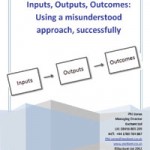
These articles explain the outcome model and how to use it properly:
- Input-Output-Outcomes: Using outcome models properly:
- We often work in clients in regulated industries whose regulator demands outcomes. Here are some examples from the water industry and OFWAT’s original perspective on Outcomes:
- Outcome thinking and the Strategic balanced scorecard: Making them work together
We have helped a three UK Water companies with their outcome thinking, overall strategy documents, and submissions to OFWAT. We have also helped various charities with their strategy and outcome thinking. If you would like help or advice in either of these areas, get in touch.
Back to contents list
10 Making strategy happen: Culture, alignment, cascading, communicating & managing
Of course you have to make your strategy happen, to execute and implement it.
10.1 Strategy & culture change: don’t believe common misconceptions & excuses

If you think strategy gets eaten by culture, we disagree. We think it is just a weak excuse for having a poor strategy for culture change. Likewise, “People don’t like change” is an excuse used by people who don’t know how to manage change to blame others for their failures. We believe this because:
- Our clients say so: Our clients tell us that the changes we helped them make, were far more effective that they expected. Often even in organisations where change has been difficult.
- Experience of making change happen: We have helped many clients through culture change. We treat culture change as a natural and embedded part of any strategy and performance management engagements.
- Successful Chief Executives as exemplars: To make ourselves even better at helping our clients manage change… We searched out and have interviewed Chief Executives who have improved their organisation’s performance through culture change.
To find out about how successful Chief Executives create culture change to support their strategy, visit our Culture Change Zone.
10.2 Creating strategic alignment, projects, resources and investment
A core part of any significant strategy is aligning the investments, and the change programmes and projects.
Strategic alignment Case study: This is a video about a major retailer, where project alignment against their strategy map found £100m worth of projects, of which £40m did not support the strategy and could be saved. Large retailer: Strategic roll-out and project alignment. Here are some articles, based on our experiences, about aligning these with the strategy:
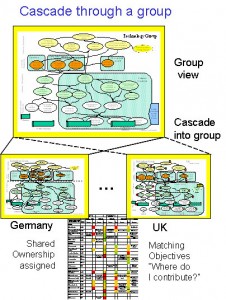
- Aligning projects and programmes with a cascade of strategy
- This is an article about wider strategic alignment: Aligning the organisations projects and investments, objectives, budgets, and meetings
- One really important piece of strategy to align is with your performance management approach. This article explains the core principles that make aligning your cascade with your strategic balanced scorecards architecture far easier.
Some people wonder where best to start with their strategy and strategic balanced scorecard. Here is a useful way Strategy roll-out: Which part of the balanced scorecard elephant to eat first.
One aspect of strategic alignment we sometimes help clients with is the objective of the team, and ultimately the team’s incentives and reward structure) and how that might trickle down through the organisation. Have a read of Changing the incentive and reward system using a balanced scorecard approach
Integrating rolling budgets with strategy can be a challenge. This may help: Integrating rolling and continuous budgeting with your strategy
We have worked on a couple of engagements where the strategic objectives in the top-level strategy map were used as a part of the Executive team’s objectives. If you would like to discuss any aspect of Executive objectives, do contact us directly.
10.3 Cascading your strategy
Cascading strategy can be about getting the strategy through the organisation to its people. This is covered in the Communicating and socialising strategy zone.
It can be about cascading it through the various business units and organisational units. How do we cascade strategy through our organisations? In this Cascading strategy video case study, we look at an example of cascading strategy to achie

ve synergy across a group of international business units: Cascading strategy for synergy (Video and white paper) How a set of manufacturing companies cascaded their strategy across the group to achieve growth through synergy.
10.4 Strategy communication & socialising strategy
Despite calling the first book “Communicating strategy” we are clear that communicating strategy is not enough. Strategy needs to be socialised. We have created a zone of the site, specifically to help executive communicate and socialise their strategy. For an Executive’s guide to Communicating Strategy and Socialising Strategy, visit our Communicating & Socialising Strategy Zone.
10.5 Managing performance and the progress of your strategy
- Stages of thinking about strategy and performance: Different types of balanced scorecard serve different management needs
- The difference between strategic and operational balanced scorecards
“We knew we had to focus on the big issues. We now are better, as a team, addressing strategic issues, sharing ownership of the big issues and taking corporate responsibility.“
“It has helped us as Directors work far more closely together, where we would not have normally. We can now lead from the top and are seen to speak in a single voice.”
“The approach has created a much greater sense of unity between the departments. It’s the combination that matters. We realise we are all culpable, together.”
Peterborough City Council
Strategy and Strategic Balanced Scorecard project
Further Topics that may help you
This page, and all the articles associated with it, were created to help people better understand this topic. Our work with clients has led us to publish nearly 400 articles & case studies, divided into closely related topics (Zones).
Why so many articles? We have a simple view: that sharing our experiences, explaining many of topics clearly, and educating people is a good thing. That is why we give so much material away. It might not bring in consultancy engagements, but it helps people avoid mistakes, and that does matter. If you have found this useful, have a browse through our other zones:
- Strategy: Our introduction to understanding strategy, its language, strategic thinking, development and making strategy happen. The Strategy Zone. Supported by four further zones:
- Make good decisions, execute them well and learn quickly in The Decision Improvement Zone.
- Manage Culture change: Does your strategy require cultural and behavioural change? Learn how in The Culture & Behaviour Change Zone.
- Communicating Strategy: Want to communicate and socialise your strategy better? The Communicating & Socialising Strategy Zone
- The 4G Strategic Balanced Scorecard: An approach to managing strategy, our organisations and our people, designed for today’s challenging organisational context The 4G Strategic Balanced Scorecard Zone
- Wider issues of Performance Management and earlier Balanced Scorecard approaches:
- Performance Management: Diagnose problems in various types of performance management systems, and understand how our beliefs influence our approach in The Performance Management Zone
- Modern Balanced Scorecards : Understand how earlier generations of balanced scorecards should work, (from someone who worked with Norton & Kaplan) The Modern Balanced Scorecard Zone.
- Paradigm Shift: The context of our organisations continues to change, affecting how we think about our organisations, and how we manage. Explore the shifts and implications, in The Paradigm Shift Zone.
Of course, there is another way to get help: by using the Contact Us form below, or give us a call.

